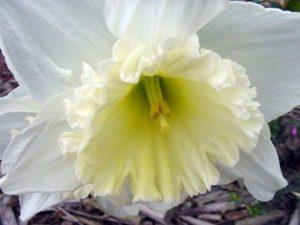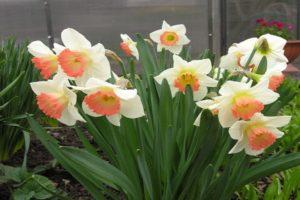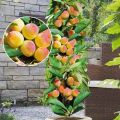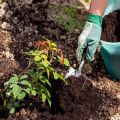Description and characteristics of the Sunny Side Up narcissus, planting and care rules
For many people, spring begins only when primroses appear on the flower beds. Daffodils with the poetic name Sunny Side Up are one of them. These plants have a wonderful appearance, like little fluffy suns. They will decorate the backyard in early spring, they will not fade for several months. Caring for primroses is simple, available even to novice gardeners.
Description and characteristics of Narcissus Sunny Side Up
Narcissus Sunny Side Up (Latin name Narcissus Sunny Side Up) is a perennial, bulbous, herbaceous plant. The variety is considered to be large-crown, orchid. Sunny Side Up flowers are reminiscent of exotic orchids. The primrose has a rather unusual appearance:
- Single lemon-yellow flowers with a diameter of about 9-10 centimeters. The crown is large, corrugated, dissected, has a bright yellow wide border. The base consists of several connected segments.
- The leaf blades are basal, elongated. Usually their number is 3-4 pieces.
- The root system is represented by a dense bulb.
- The height of an erect, strong peduncle is 40-45 centimeters. A flower is placed at its top.
- After flowering is complete, a fruit is formed - a seed capsule.
Leaves crawl out of the soil immediately after the snow melts. And after a while, stems and flowers appear.

Pros and cons
The downside of daffodils is that after flowering, the leaves cannot be torn off. They wither for a long time on their own, spoil the appearance of flower beds.
Growing specifics
Sunny Side Up primroses are grown in the same way as regular daffodils.
Landing dates
In Central Russia, the period from the third decade of August to mid-September is considered the best time for planting primroses. These terms are good because the planting material takes root before the onset of frost. This means that the plant will better endure the winter period and will bloom quickly in the spring.

Selecting and preparing a landing site
Sunny Side Up primroses prefer sunny areas or places where there is a slight partial shade.
First, the land on the future flower garden is cleared of weeds, dug up, fertilized. Dig holes 15-20 centimeters deep, keeping a distance of 10-15 centimeters between them. If the soil is heavy, then the depth is slightly reduced.
Preparation of planting material
If the gardener has Sunny Side Up daffodil beds, the bulbs are first removed from the soil and separated. The dug out or purchased planting material is soaked in a strong solution of potassium permanganate. This procedure is a means of preventing all kinds of rot and fusarium.

Planting process
A handful of wood ash is poured into each hole. The prepared bulbs are planted one by one, covered with soil, which is lightly tamped.
Flower Care Tips
Narcissus Sunny Side Up is an unpretentious plant. To make it feel good, the gardener needs to do standard grooming operations.
Watering and fertilizing
After planting, the plants need constant moisture as the soil dries out. This is especially true when leaves and buds begin to appear. Abundant watering is required at a time when the Sunny Side Up is gathering buds. If there is not enough liquid, then the flowers will begin to dry out and fall off.
But, at the same time, it is worth making sure that there is no excess of liquid, especially where the soil contains a lot of clay inclusions. After the end of flowering, irrigation is continued until the leaf blades are completely wilted.

It is important to constantly feed daffodils:
| Feeding No. | Plant development phase | Fertilizer composition |
| 1. | Mass seedlings | Containing nitrogen |
| 2. | The appearance of buds | More potassium |
| 3. | Abundant flowering | Complex fertilizer |
| 4. | After flowering ends | Containing phosphorus |
Mulching and loosening
Sunny Side Up daffodils need constant hand weeding combined with loosening. If you do not carry out these procedures, then flowering will not be long. There will not be enough nutrients to form healthy bulbs.
In order for the soil to remain moist for a long time, there were as few weeds as possible, flower beds can be covered with mulch in the form of rotted sawdust, crushed tree bark. In addition, if you combine the right color scheme, the flower bed will look attractive.

Pruning
Pruning of plants is carried out periodically, during the entire summer season. This is necessary in order for the appearance of the flower bed to be attractive and so that nutrients go to the healthy parts of the plant. Remove the following components:
- wilting flowers - until the seeds begin to form;
- with a slight defeat by rot and other diseases;
- completely dried leaf blades. Previously, it is not worth removing them, because all the nutrients from the leaves go to the bulbs.
If the gardener did not manage to remove part of the primrose at the very beginning of the disease, then the entire plant will have to be removed.
Preparing for winter
Sunny Side Up are considered winter-hardy and do not need protection from the cold.

Disease and pest control methods
For the prevention of diseases and at their first signs, primroses are sprayed with copper-containing fungicides.
Flower propagation
The seeds are not used for propagation of Sunny Side Up daffodils. Only bulbs are used for this purpose.

Using Sunny Side Up in Landscaping
Sunny Side Up should not be planted in arrays. When they bloom, they look great. But after the completion of this process, their leaves do not die off for a long time, they have a sloppy appearance. They spoil the whole large-scale composition.
It is better to plant daffodils in groups of 6-10 pieces and surround them with perennial herbs. After the primroses have finished blooming, the greenery will cover the withering leaf blades of the Sunny Side Up.









